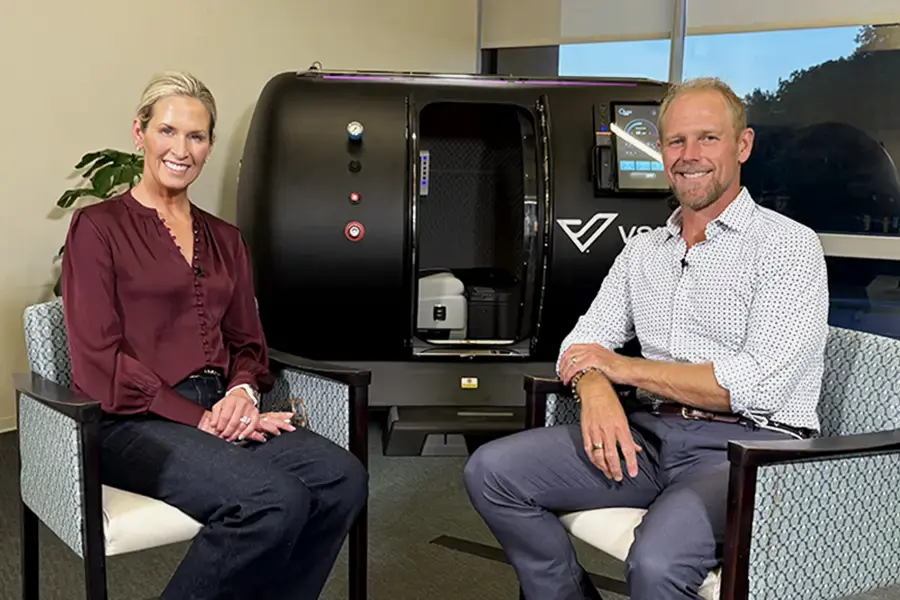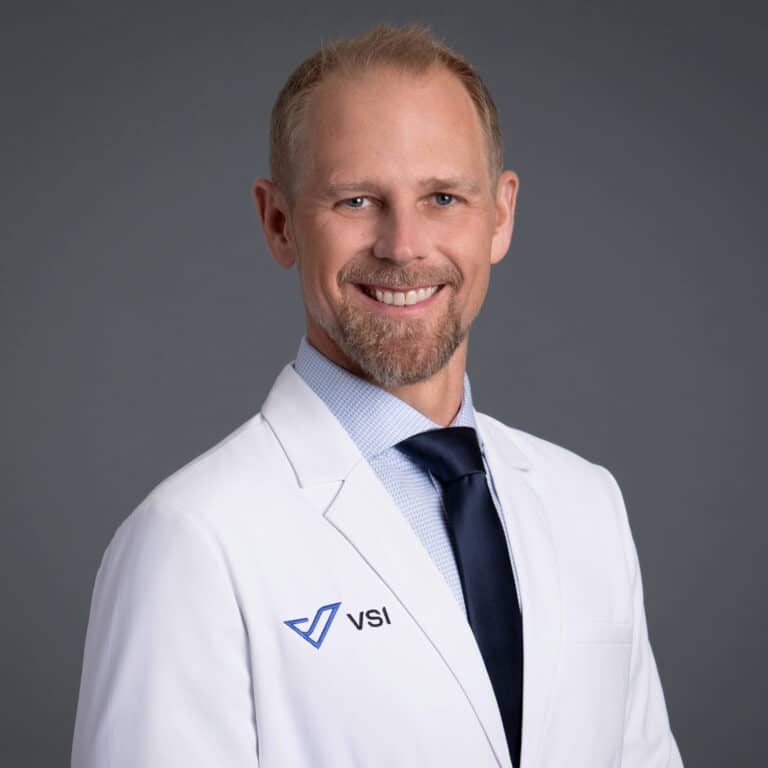
Oxygen Therapy for Advanced Spine Surgery Recovery
What if the secret to healing faster was already in the air you breathe?
In a special on-location episode of the Get Back to Your Life® Podcast, Dr. Christopher Good, Spine Surgeon and President at VSI, reveals one of the latest breakthroughs in spine surgery recovery: Hyperbaric Oxygen Therapy. This innovative treatment is now being used right here at VSI to help patients who suffer from back and neck pain recover faster and more completely than ever before.
Listen to learn:
- How oxygen therapy accelerates healing and reduces pain
- Why it’s becoming a key tool in spine surgery recovery
- What a hyperbaric session feels like, and who should consider it
- How oxygen therapy fits into VSI’s Recovery Revolution™ model for optimal recovery outcomes.
The Science Behind Hyperbaric Oxygen Therapy
Hyperbaric oxygen therapy has been around for decades, traditionally reserved for critically ill patients facing severe complications. But Dr. Good and the team at VSI recognized that if enhanced oxygen delivery can save limbs, imagine what it could do for patients recovering from spine surgery.
Watch Podcast on YouTube
How Oxygen Therapy Works
VSI’s state-of-the-art hyperbaric oxygen chamber delivers 100% oxygen under increased atmospheric pressure. Under normal conditions, we breathe room air containing about 21% oxygen at one atmospheric pressure. Our hemoglobin is already nearly full at 96 to 98% saturation.
The hyperbaric chamber changes everything. Operating at 2 ATA (double normal atmospheric pressure), the treatment drives oxygen directly into your blood plasma. This bypasses the normal hemoglobin pathway entirely, allowing oxygen levels to reach up to 400% of normal capacity.
“When we go in a hyperbaric chamber and it increases the pressure, it actually drives oxygen into the plasma, the fluid of our blood,” Dr. Good explains. “And so now we’re delivering oxygen in a whole new way.”
Why Oxygen Matters for Recovery
After spine surgery, your body faces multiple healing challenges: incisions that need to seal, muscles requiring repair, inflammation that must be controlled, and potentially bone fusions or implants depending on the procedure.
“If we’re talking about like a surgical procedure, if we have a surgery, we have an incision we’re trying to heal, we have muscles we’re trying to heal, we have inflammation we’re trying to combat,” Dr. Good notes. “Anything we can do to improve the biologic environment can help with that healing.”
Results of Hyperbaric Oxygen Therapy
The benefits extend beyond theory. For patients with risk factors for infection, the improvements are dramatic. “If I have someone who has some risk factors for maybe getting an infection, getting them in the hyperbaric chamber before and after surgery, I’m seeing these people’s wounds seal up like gangbusters,” Dr. Good shares.
Even for patients in excellent health with already high success rates, hyperbaric therapy pushes those odds even higher. “Thankfully a lot of our patients already have really great chances of success with whatever we’re doing. But every percentage point I can increase that, I want to go for that.”
The Experience Inside the Chamber
For those curious about what a hyperbaric session feels like, Dr. Good offers a firsthand account. The chamber is spacious enough to accommodate two or three people comfortably, with a reclining chair, flat bench, climate control, and a television.
The treatment takes about an hour. During the first 10 minutes of pressurization, “you feel like your ears are popping a lot, you know, you have to yawn just like a plane that’s going up and down pretty quickly.” Once at stable pressure, most people feel perfectly normal.
After treatment, Dr. Good reports a burst of energy. But perhaps the most intriguing benefit is improved sleep quality. “My sleep the day after I do the hyperbaric chamber or my sleep when I’m using the hyperbaric chamber a couple times a week, I really get a much better sleep after that.”
Watch Dr. Good’s HBOT Tour
VSI’s Recovery, Reimagined
Hyperbaric oxygen therapy represents more than just a new technology at VSI. It reflects an entirely new philosophy of healing: the Recovery Revolution™.
Traditional recovery models leave patients waiting. You have surgery, go home with medications, and wait two weeks for your follow-up appointment. Only then does physical therapy typically get scheduled.
“I want to program all that out before if I know the patient, I know their surgery,” Dr. Good emphasizes. “I know day five, this is optimal. Day six, this is optimal. I want to plan out their whole recovery ahead of time, proactively.”
This revelation came partly from Dr. Good’s own experiences as a patient. After undergoing regenerative medicine procedures himself, he recognized how much better he could have felt with proper planning. “Once I got to the end I said, I should have done this, I wish I’d have done that and so we were able to refine our protocols.”
True, Lasting Recovery from Spine Surgery
The timing matters enormously. “When do you feel worst after surgery, the first two weeks, right?” Dr. Good points out. “And if you get in with a really great therapist and they depending on what you need, but they they treat you with the infrared laser, they treat you with massage, we get you doing some light exercise to release endorphins in your body… there’s a lot of techniques that we can use really early on to make a huge difference.”
For patients considering spine surgery, the recovery conversation should begin before the procedure itself. In an ideal scenario, patients visit the hyperbaric chamber once or twice in the week leading up to surgery. After surgery, approximately 10 hyperbaric sessions optimize the healing timeline, coordinated with physical therapy and other recovery modalities.
One patient’s story illustrates the potential: “5 days after her surgery, she’s here, right? She’s in hyperbaric. She’s working with a therapist. She’s getting an aquatic treadmill, you know? And if you look at it, we we got almost, you know, 10 or 14 days of like important beneficial treatments in before the first post-operative visit.”
A New Standard in Spine Care
VSI’s investment in safe hyperbaric oxygen therapy represents something unprecedented. “I don’t know of another spine or orthopedic practice like ours that has chosen to do this,” Dr. Good notes. “Most of the hyperbaric chambers that are in use are I believe lower power chambers at a wellness spa or really powerful chambers at big universities.”
This uniqueness extends to the data VSI plans to collect. VSI’s comprehensive tracking systems position the practice to demonstrate how enhanced oxygen delivery benefits patients who are already on track for good outcomes.
Taking Control of Your Recovery
The most important takeaway for patients considering spine surgery isn’t just about hyperbaric oxygen therapy itself. It’s about recognizing that recovery deserves the same careful planning as the surgery itself.
“The number one question is like, how much is it going to hurt?” Dr. Good observes. “And anything we can do to modulate and improve that early on, getting expert hands, you know, involved, it makes a huge deal for patients.”
Before scheduling surgery, patients should ask detailed questions about the entire recovery protocol. What will the first two weeks look like? When should physical therapy begin? What modalities will be used and when?
The goal is clear: “I want to see people schedule their surgery and schedule their recovery all at once.”
At VSI, the future of spine surgery recovery is already here. Backed by comprehensive research and driven by a commitment to continuous improvement, the Recovery Revolution™ combines advanced surgical techniques, regenerative therapies, and proactive planning to help patients heal faster, reduce pain, and return to life stronger than before.
For additional resources and to learn more about hyperbaric oxygen therapy and VSI’s comprehensive approach to spine care, visit spinemd.com/recovery.
Topics covered
About the Author
Featured Resources
Insights to Achieve a Pain-Free Life



